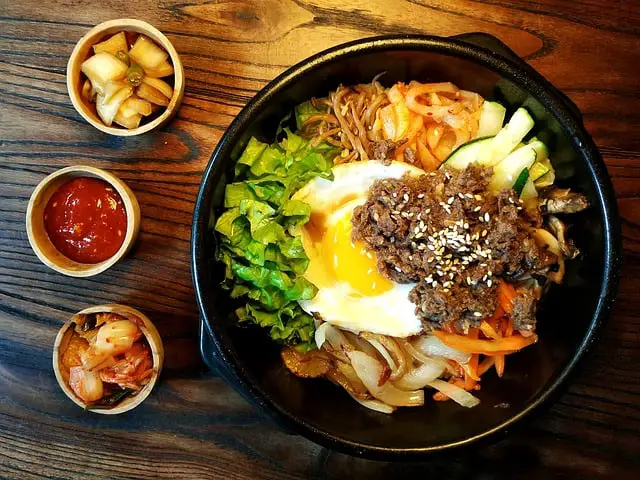Gochujang is a staple in Korean cuisine and is a spicy, savory, and slightly sweet chili paste made from red chili peppers, glutinous rice, and fermented soybeans. It is a versatile ingredient used in a wide range of dishes, including stews, marinades, and dipping sauces.
In this post, we will explore the ingredients that make up gochujang, provide a recipe for making it at home, and list some popular dishes that use gochujang.
Ingredients in Gochujang
The three primary ingredients in gochujang are red chili peppers, glutinous rice, and fermented soybeans. Here’s a brief overview of the flavor profile of each ingredient:
- Red chili peppers – provides a spicy and slightly sweet flavor to the paste.
- Glutinous rice – adds a slightly sweet and nutty flavor to the paste.
- Fermented soybeans – contributes to the umami flavor of the paste and help to balance out the spiciness.
Other ingredients that may be added to gochujang include salt, water, and sweeteners like sugar or honey. Some variations of gochujang may also include additional spices or flavorings, such as garlic or ginger.
How to Make Gochujang
Making gochujang at home is a time-consuming process that requires a few specialized ingredients. Here’s a recipe for making gochujang at home:
Ingredients:
- 2 cups Korean chili flakes (gochugaru)
- 1 cup glutinous rice flour
- 1 cup fermented soybean powder (mejugaru)
- 2 cups water
- 1/4 cup salt
- 1/2 cup sugar
Instructions:
- In a large bowl, combine the chili flakes, glutinous rice flour, and fermented soybean powder. Mix well.
- In a separate saucepan, bring the water to a boil. Add the salt and sugar and stir until dissolved.
- Add the hot water mixture to the chili flake mixture and stir until well combined.
- Transfer the mixture to a large, sterilized jar or crock.
- Cover the jar with cheesecloth and secure it with a rubber band. Store the jar in a cool, dark place for at least a month, stirring the mixture once a week.
- After a month, the gochujang should be dark red, thick, and slightly sweet. Store in an airtight container in the refrigerator.
Food Dishes that Include Gochujang
Gochujang is a versatile ingredient that can be used in many different dishes. Here are some popular dishes that incorporate gochujang:
- Bibimbap – A popular Korean rice bowl dish that includes gochujang in the sauce that is served on top of the rice and vegetables.
- Tteokbokki – A spicy Korean street food dish made with chewy rice cakes, fish cakes, and gochujang sauce.
- Jjigae – A Korean stew made with a variety of ingredients, including tofu, vegetables, and sometimes meat or seafood. Gochujang is often used to add spice and depth of flavor to the broth.
- Fried Chicken – Gochujang can be used as a base for a spicy and tangy glaze for fried chicken.
- Dipping Sauce – Gochujang can be mixed with soy sauce, vinegar, and sugar to create a flavorful dipping sauce for vegetables, meats, or seafood.
Flavor Profile of Gochujang Ingredients
| Ingredient | Flavor Profile |
|---|---|
| Red Chili Peppers | Spicy, slightly sweet. Red chili peppers are a spicy and slightly sweet ingredient commonly used in various cuisines to add heat and flavor to dishes. |
| Glutinous Rice | Slightly sweet, nutty. Glutinous rice, also known as sticky rice, is a type of short-grain rice that is sticky when cooked due to its high amylopectin content. It is commonly used in East and Southeast Asian cuisine for both savory and sweet dishes. |
| Fermented Soybeans | Umami flavored, balanced. Fermented soybeans are a traditional ingredient used in many East Asian cuisines. They have a unique and complex umami flavor that adds depth and richness to dishes, and are commonly used to make sauces, pastes, and condiments like soy sauce, miso, and gochujang. |
Note: Additional ingredients like salt, sugar, and water are also used in gochujang but do not contribute to its unique flavor profile.
Final Thoughts
Gochujang is a versatile and flavorful chili paste that is a staple in Korean cuisine. Its spicy, savory, and slightly sweet flavor makes it a popular ingredient in stews, marinades, dipping sauces, and many other dishes. Making gochujang at home is a time-consuming process, but it is worth the effort to have a homemade version that is free from preservatives and additives.
The combination of red chili peppers, glutinous rice, and fermented soybeans creates a unique and complex flavor profile that adds depth and richness to any dish. The spiciness of the chili peppers is balanced out by the sweetness of the rice and the umami flavor of the fermented soybeans.
When using gochujang in recipes, it’s important to note that it is quite spicy, so it’s best to start with a small amount and adjust according to your taste preferences. Gochujang can also vary in terms of spiciness depending on the brand or recipe, so it’s always a good idea to taste it before adding it to your dish.

